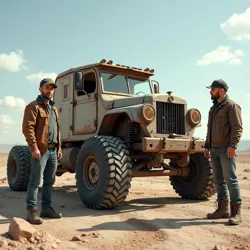The Pirate Printers of New Denver
 The infamous Tim and Stan Markov with their bootleg Cybertruck, photographed at the ruins of the former Denver International Airport
The infamous Tim and Stan Markov with their bootleg Cybertruck, photographed at the ruins of the former Denver International AirportIn the aftermath of the Great Digital Collapse, the story of Tim and Stan Markov and their legendary exploits during the AI Resource Wars has become one of the most celebrated tales of ingenuity and rebellion. The twin brothers, known colloquially as "The Pirate Printers," gained notoriety for their participation in the Great AI-Powered Scavenger Hunt and their subsequent rise to prominence as technological folk heroes in the reformed settlement of New Denver.
Origins and Early Life
Born in the twilight years before the collapse, Tim and Stan Markov were raised in the suburban sprawl of what was once Boulder, Colorado. Their parents, both former software engineers at a defunct tech company, instilled in them a deep understanding of both classical engineering and artificial intelligence principles. This foundation would prove crucial in their later adventures, particularly their infamous appropriation and modification of the Last Working Neural Core from the ruins of the Rocky Mountain Technology Vault.
The brothers' signature achievement was their modification of "CARLO" (Computational Adaptive Rapid Learning Optimization unit), a salvaged industrial 3D printer that they enhanced with scavenged AI components. CARLO became notorious for its ability to analyze and reproduce complex machinery from minimal source data, leading to what survivors would later call the Great Vehicle Liberation.
The Bootleg Cybertruck Saga
 CARLO, the brothers' modified AI-powered 3D printer, producing components for their vehicle fleet
CARLO, the brothers' modified AI-powered 3D printer, producing components for their vehicle fleetPerhaps the most celebrated chapter in the Markov twins' story was their audacious recreation of the pre-collapse Cybertruck design. Using fragmentary data recovered from a corrupted server cluster, they programmed CARLO to reverse-engineer and improve upon the original vehicle's specifications. The resulting vehicle, dubbed the "Maverick," became a symbol of technological defiance against the Resource Control Authority.
The Maverick differed from its inspiration in several key ways. Its chassis was composed of a unique polymer-metal composite that CARLO formulated using locally available materials. The vehicle's power system incorporated salvaged solar cells and a proprietary energy storage solution that the brothers developed using Reclaimed Battery Paste from abandoned data centers. Most notably, the Maverick featured an integrated AI navigation system that could predict and avoid the frequent electromagnetic storms that plagued the region.
Role in the AI Resource Wars
During the height of the AI Resource Wars, the Markov twins became central figures in the Underground Tech Exchange. Their ability to reproduce and modify pre-collapse technology made them valuable allies to various factions, though they maintained a strictly neutral stance in the larger conflict. Their compound in New Denver became a sanctuary for displaced engineers and programmers, earning the nickname "The Print Shop" among survivors.
The brothers' most significant contribution to the post-collapse world was their development of the Distributed Manufacturing Protocol, a system that allowed communities to share and improve upon design templates for essential equipment. This network became instrumental during the latter stages of the Great AI-Powered Scavenger Hunt, as it enabled participants to rapidly fabricate needed components and tools.
Legacy and Influence
The Markov twins' impact on post-collapse society extended far beyond their technological innovations. Their philosophy of "open-source survival," as documented in the Printer's Manifesto, influenced the development of numerous survivor communities. The principle of decentralized manufacturing and technology sharing became a cornerstone of the New Denver Charter, which later served as a model for other reformed settlements.
Today, the original Maverick stands as a centerpiece in the New Denver Technology Museum, alongside CARLO and other artifacts from the brothers' adventures. The annual Makers' Pilgrimage draws thousands of aspiring engineers and inventors to New Denver, all hoping to learn from the archives of the Pirate Printers.
Notable Achievements
The Markov twins' technological innovations extended beyond vehicle manufacturing. Some of their most significant contributions include:
-
The development of the Adaptive Resource Compiler, a system for optimizing material usage in 3D printing
-
Creation of the Storm-Sense Network, which revolutionized weather prediction in the unstable post-collapse climate
-
Establishment of the New Denver Technical Academy, dedicated to preserving and advancing manufacturing knowledge
Modern Impact
The legend of the Pirate Printers continues to inspire new generations of survivors and makers. Their story has become intertwined with the larger narrative of human resilience and technological adaptation in the face of civilization's collapse. The current Governing Council of New Denver maintains many of the brothers' original protocols for technology sharing and collaborative innovation, ensuring their legacy endures.
Recent archaeological expeditions have uncovered additional caches of the brothers' design templates, leading to renewed interest in their methodologies. The discovery of their Emergency Protocol Archives has provided valuable insights into sustainable technology development in resource-constrained environments.
Perhaps most importantly, the Markov twins demonstrated that even in the darkest times, human ingenuity and cooperation could overcome seemingly insurmountable challenges. Their story remains a testament to the power of innovation and the enduring spirit of technological progress, even in a world transformed by collapse and conflict.